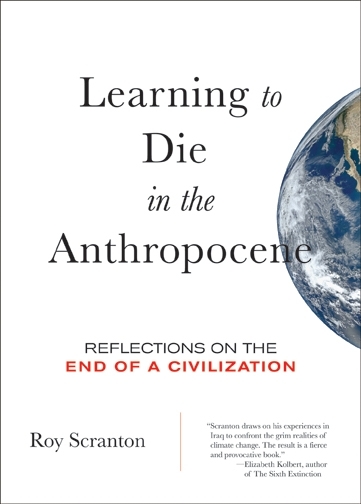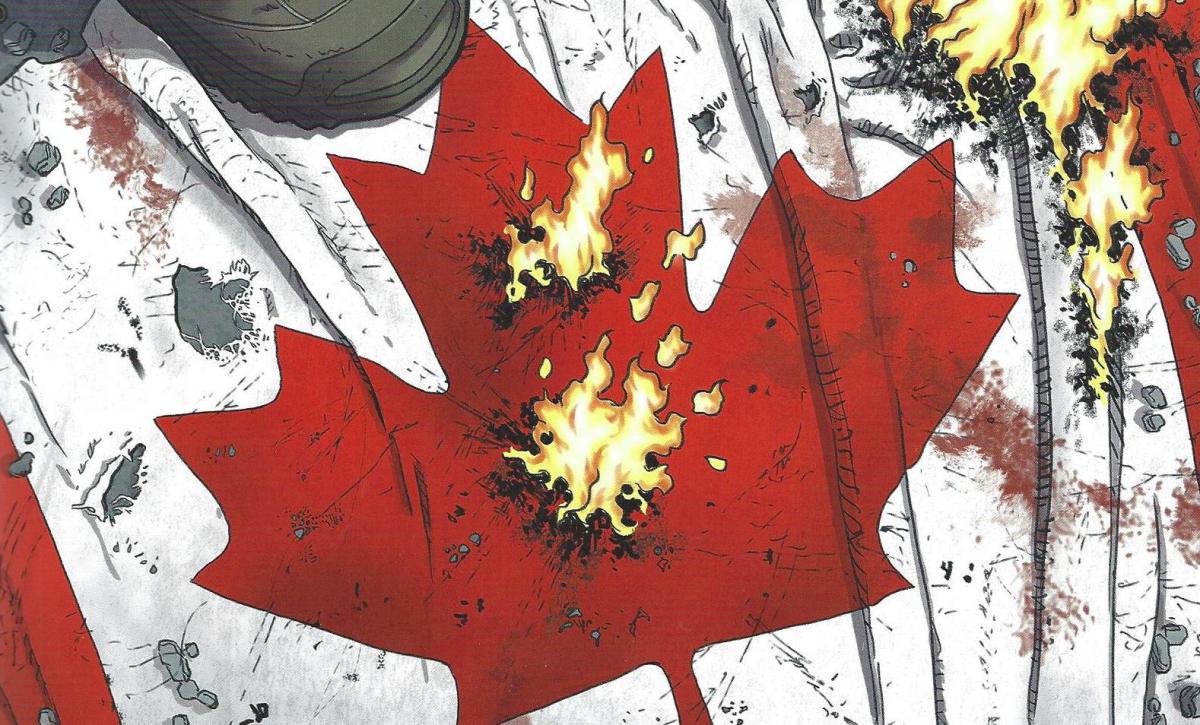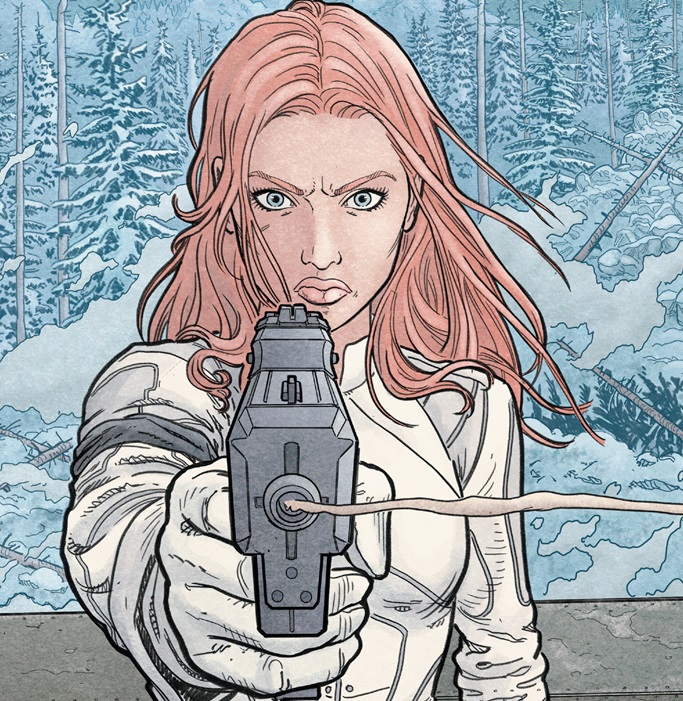The recent Paris Climate Conference has been called the last best chance for the leaders of the world, nations and multinational corporations, to agree upon a framework that can somewhat mitigate and limit the compounding effects of climate change. Some have commented that a best-case scenario for such an agreement would still not prevent a future of unbearable heat and widespread famine, drought, war, and mass migrations; a total failure to reach a feasible agreement, like the previous iteration in Copenhagen in 2009, would mean much, much worse: no less than the end of human civilization as we know it and the extinction of huge numbers of plant and animal species, possibly including homo sapiens. Roy Scranton, in his new book Learning to Die in the Anthropocene: Reflections on the End of a Civilization, cleaves to the latter option as the most likely scenario, and this slim volume is dense with big history, scientific nitty-gritty, and philosophical reflections.
Scranton opens the book by invoking his experience as a soldier in the Iraq War, driving and patrolling through Baghdad and pondering the collapse of a once-bustling ancient city into chaos and violence. Back home in the States and safe once again, he witnessed the similar breakdown of order and imposition of martial law in New Orleans after Hurricane Katrina. Scranton connects these localized disaster zones of social breakdown with the future fate of the planet and the human race when climate change accelerates and worsens. He cites a litany of military planners, economists, and scientists to draw his indisputable and alarming conclusion: “Global warming is not the latest version of a hoary fable of annihilation. It is not hysteria. It is a fact. And we have likely already passed the point where we could have done anything about it.” Sobering words.
Over the next four chapters, we are treated to a God’s eye view, in the style of Spinoza’s sub specie aeternitatis, of geological eras, the rise of homo sapiens, the evolution of energy and industry, the seemingly intractable conundrum of the greenhouse gas effect, the near impossibility that the nations and leaders of the world will come to a working solution that will fix things, and the universality of violence in our primate species. Scranton presents well-researched and argued points on an impressive range of topics with a concise and continually compelling sense of conviction.
The fifth and final chapter, entitled “A New Enlightenment”, is the most original, interesting, challenging, and vexing part of the book. Scranton opens with an epigram from the Epic of Gilgamesh, one of the oldest pieces of literature on earth which was rediscovered by chance only 150 years ago. The epic tells of the adventures of the powerful king Gilgamesh and his wild companion, Enkidu, as they unite their opposing forces against the gods themselves, forcing the gods to strike down Enkidu. Gilgamesh becomes distraught over the death of his friend and wanders the earth seeking a way to conquer death. Frustrated in the end, Gilgamesh curses the futility of existence. His experience lives on, though, and offers, as Scranton says, “a lesson in the importance of sustaining and recuperating cultural heritage in the wake of climate change.” It also represents “not only the fragility of our deep cultural heritage, but its persistence.” For the author, the specter of climate change is such a monumental problem that we have no hope of solving it; rather, we should focus on maintaining and deepening our humanism and protecting our rich cultural legacy in order that we will both have a softer descent into the envisioned post-apocalyptic future, and that this rich heritage painstakingly accrued over millenia may be rediscovered one day by our survivors in order to rebuild a new civilization. Our study of philosophy, the ancient classics, and Shakespeare, as rewarding as it may be, creates something of a non sequitur when used as a transition to the idea that our unfortunate inheritors will be fighting for resources and survival in a post-apocalyptic world where life will revert to that pre-state existence invoked by Hobbes: “No arts; no letters; no society; and which is worst of all, continual fear and danger of violent death; and the life of man solitary, poor, nasty, brutish, and short.”
Learning to Die in the Anthropocene is a far-reaching, erudite, and cultured book with a bleak view of humanity and its future. The author draws upon a wide variety of philosophical ideas to make his point, from Heraclitus (“Life, whether for a mosquito, a person, or a civilization, is a constant process of becoming…Life is a flow.”), to Hegel (“The human being is this Night, this empty nothingness which contains everything in its simplicity.”), to Heidegger (“We fall into the world caught between two necessities, compelled to live, born to die, and reconciling them has forever been one of our most challenging puzzles.”). More than any schools of thought, though, it seems like the author subscribes on some level to the Stoicism of Epictetus, Seneca, and Marcus Aurelius when he says “Learning to die means learning to let go of the ego, the idea of the self, the future, certainty, attachment, the pursuit of pleasure, permanence, and stability. Learning to let go of salvation. Learning to let go of hope. Learning to let go of death.” This echoes once again the oft-repeated quote by Montaigne that “to philosophize is to learn how to die.” In both the title of this book and the many references to “learning to die”, I think we could easily substitute the phrase “philosophizing” without losing any significance; for Scranton envisions a dying world in which we will all need to become philosophers if we are to hold onto our humanity.
Fear of death is universal among humans and many of the higher mammals. It likely spawned our myths as well as our art. It is only the philosophers who do not avoid it or fear it, but look it clearly in the face. This is true of Democritus, Socrates, Epicurus, the Zen Masters, the Bodhisattvas, Hume, Schopenhauer, Wittgenstein, and many others who have spent their lives contemplating death not as a morbid fascination but as a means to improving and perfecting their own lives. If it is difficult for most people to attain such peacefulness of mind even after a lifetime of meditation, it is even more unfathomable to find any comfort in the inconvenient truth that the Earth will be rendered uninhabitable in a few million years, and that the cold death of the universe will follow in its wake a few billion years later. The cycle of life and death does not occur on an individual level, or even that of an entire species; it includes planets, stars, and the universe itself. Numerous other books, films, and stories, including Learning to Die in the Anthropocene, discuss this tragic reality in one way or another; Alan Weisman’s The World Without Us, Asimov’s “The Last Question”, Ingmar Bergman’s The Seventh Seal, Lars Trier’s Melancholia, Lucretius’ On the Nature of Things, and the Samurai manual Hagakure, which Scranton read in Iraq as a way of dealing with the pervasive and daily dance of death.
Everything in the book springs from the idea that global warming is a problem too big for humans to deal with based on the total lack of realistic and practical alternatives we have to stop it. On this point, I fully understand the enormity of the problem, the almost complete lack of political and corporate will to change our entire world economic system and sacrifice short-term profit, and the bleakness of the future we therefore guarantee for ourselves; but I do not, and cannot, fully endorse the complete resignation of the search and struggle for solutions that the author advocates. On the merits, I have no issue with any of his conclusions except for his certainty of failure in the face of global warming. I am by no means hopeful about the state of the climate and the geopolitical effects that my children will witness, but I think that is exactly why pervading pessimism must give way to de rigueur active optimism for the sake of our survival. The current Paris Climate Conference will be not the last best chance, but the first great step to further increase momentum towards a global solution to the extremely daunting but not impossible crisis we face. If that means a change away from neoliberal capitalism towards a more sustainable future, as Scranton alludes to, so be it.
Overall, the book is exceedingly ambitious and almost too wide-ranging for its own good, and it feels like the solution offered by the author in the face of a crisis he goes to great lengths to explain renders the conclusion relatively feeble and unconvincing. It is not really a work of philosophy as much as a cri de coeur over the indispensability of philosophy and the humanities as a way of securing “the fate of humanity itself.” I do believe, along with the author, that a deep sense of compassion and humanism are necessary to continued civilization, but so are collective action. My grasp of philosophy helps me cope with the thought of my and the world’s eventual annihilation, but my appreciation of human craft, art, technology, and collective potential to solve problems tells me that we will not go gently into that good night.
_____
David James did two tours in Afghanistan with the 173rd Airborne Brigade, and he now teaches English in Italy. He co-edits a website with other veterans at www.wrath-bearingtree.com and maintains a personal blog at www.tigerpapers.net.












